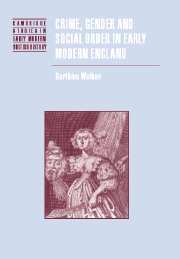Book contents
- Frontmatter
- Contents
- List of figures and tables
- Preface
- Note on quotations and dates
- List of abbreviations
- 1 Introduction
- 2 Men's non-lethal violence
- 3 Voices of feminine violence
- 4 Homicide, gender and justice
- 5 Theft and related offences
- 6 Authority, agency and law
- 7 Conclusion
- Bibliography
- Index
- Titles in the series
1 - Introduction
Published online by Cambridge University Press: 14 July 2009
- Frontmatter
- Contents
- List of figures and tables
- Preface
- Note on quotations and dates
- List of abbreviations
- 1 Introduction
- 2 Men's non-lethal violence
- 3 Voices of feminine violence
- 4 Homicide, gender and justice
- 5 Theft and related offences
- 6 Authority, agency and law
- 7 Conclusion
- Bibliography
- Index
- Titles in the series
Summary
HISTORIES OF CRIME AND GENDER
In an important review essay of 1986, Joanna Innes and John Styles described the social history of crime and the criminal law as ‘one of the most exciting and influential areas of research in eighteenth-century history’. It would be somewhat optimistic to make such a statement today about the field as a whole. In some respects, the history of crime appears to be a history that has been standing still. One may observe that the field is not so much reflective of new approaches and interpretations as it is the honing of older ones. Much recent work remains characterised by aspects of what in the 1970s and 1980s was known as the ‘new’ social history approach. Books are still produced in the mould of ‘history from below’ or which draw on the methods of positivist social science in order to identify patterns in social behaviour by, for example, counting numbers of indictments and analysing statistically verdicts and sentences over time. It is noticeable that the approach, assumptions and scope of some recent contributions, while being fine pieces of scholarship in their own terms, are similar to those of older works. In this present work, I wish not to dismiss these traditions, but to develop their strengths.
The ‘new’ social history approach remains fruitful.
- Type
- Chapter
- Information
- Publisher: Cambridge University PressPrint publication year: 2003

